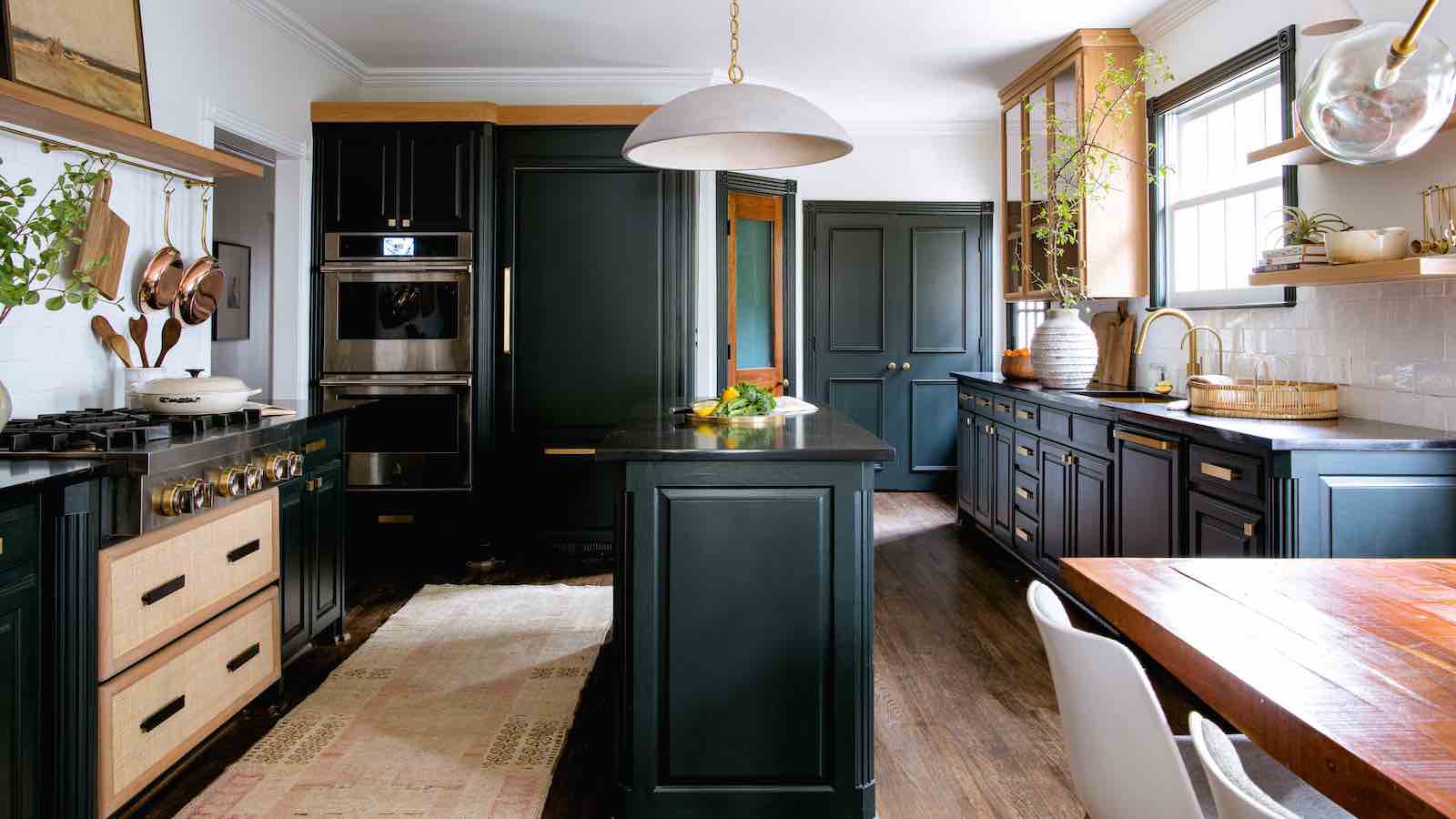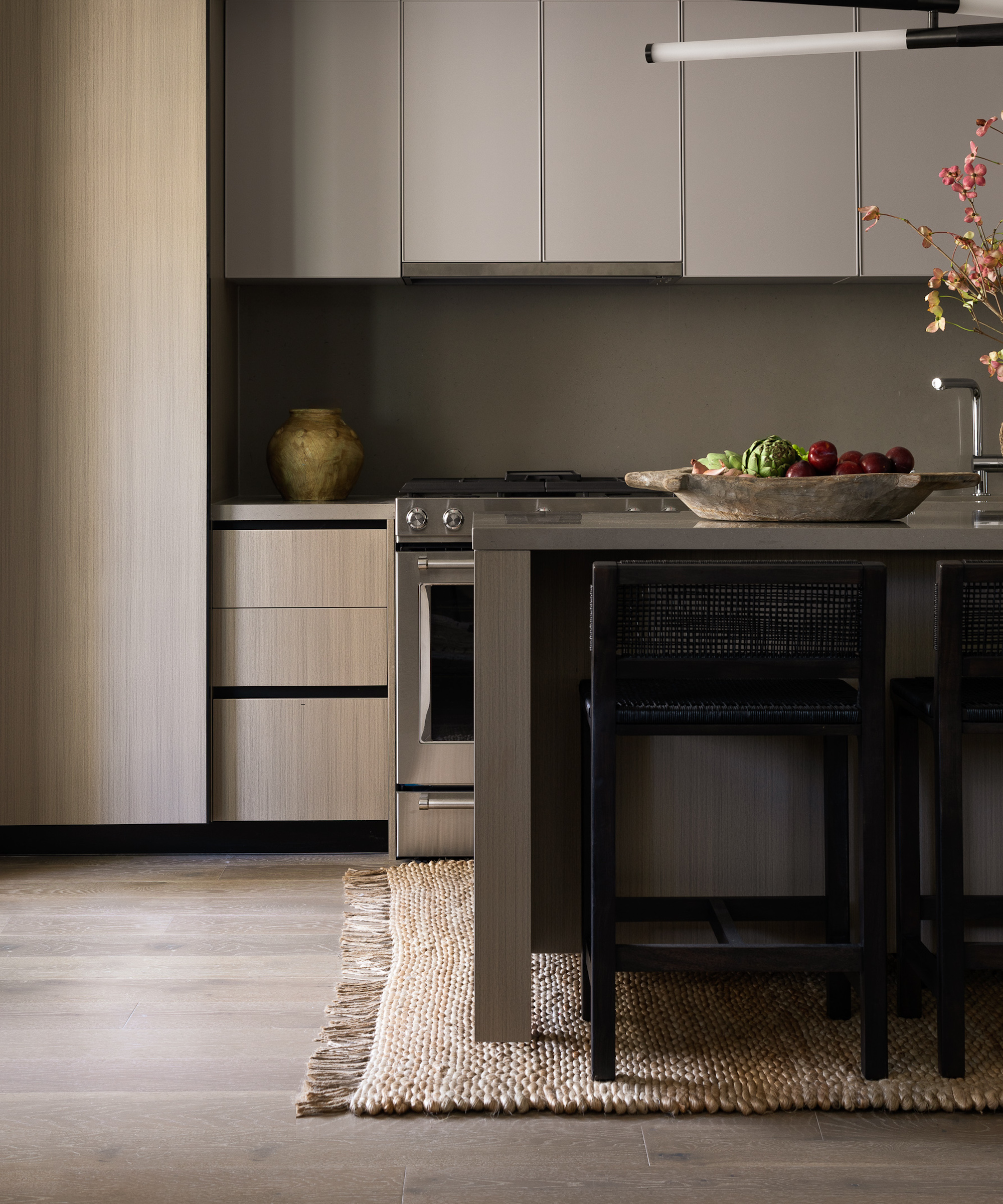8 kitchen rug placement rules you need to know, according to design experts
Get rug positioning locked down in this high traffic room


As kitchens become much more sociable spaces, used not just for cooking but throughout the day, so kitchen ideas become cozier and more inviting. Introducing color, texture and pattern is the secret to a liveable space, and kitchen rugs play a pivotal role.
‘Rug placement in a kitchen might not feel as obvious compared to rooms where having a rug is standard. However, the kitchen is just as much a living space as any other, and the same rug placement rules apply,’ points out interior designer, Kara Childress.
Regardless of placement, a low-pile or flat-weave style rug works best in the kitchen, as it minimizes trip hazards and allows for easy maintenance in this high-traffic area. Do ensure your chosen rug has a non-slip backing or use a separate anti-slip mat beneath to secure your rug in position. This latter point is vital in a room in which you carry hot pans.
Kitchen rug placement rules
From defining traffic routes and protecting flooring, to improving comfort and enhancing design cohesion, understanding the principles of kitchen rug placement will help ensure your kitchen rugs are a worthy investment and reach their full design potential. Read on to learn the secrets of mastering kitchen rug placement from the experts.
1. Two can be better than one

There are many reasons why two rugs can work better than one. Annie Burrows, lead designer at Blakes London, advocates doubling up underfoot. ‘Rugs tend to become disproportionately more expensive the larger they become, so choosing two rugs not only allows for more choice on the market, but also increases flexibility and practicality in situ, all while likely being a more cost-effective solution,’ she says.
Two rugs create a more contemporary aesthetic to one long runner helping to break up and soften a long, narrow walkway. ‘Hygiene wise, two smaller rugs are easier to move and clean beneath and are also more likely to fit within a standard washing machine, because should you wish to place a rug in a kitchen, we really would suggest it's one that is machine washable,’ adds Annie.
Smaller rugs are easier to position strategically into high traffic areas to help the wear and tear of a floor. This is particularly important if using natural porous stones or timber. Smaller rugs are also easier to adjust periodically which can help to avoid patchy sun damage to the floor.
Design expertise in your inbox – from inspiring decorating ideas and beautiful celebrity homes to practical gardening advice and shopping round-ups.
2. Place a rug under a portable island or table

If your central kitchen feature is a cook’s table or portable kitchen island unit, Hanna Li, cofounder of Hanna Li Interiors, recommends placing a rug beneath. ‘When designing a multipurpose kitchen or working within a tight space, having a mobile island or central table is incredibly convenient as they can be moved out of the way when more space is required for entertaining,’ she says. ‘However, the weight of the island can potentially damage the flooring. To address this issue, adding a rug and rug pad can provide protection while also adding a practical and soft surface to stand on.’
Beyond functionality, Hanna believes a central rug serves as a nice detail and can prove more practical than runners in the space, as they may otherwise get shifted around in a high-traffic zone. ‘Additionally, if the island or table accommodates seating, the rug will create a cozy and inviting environment,’ she adds. ‘Depending on the island size, the rug size is recommended to be 1-2ft wider than the island on both ends of where the island waterfalls, and 3-4 ft where stools are placed and on the opposite side of the stools to match.’

Hanna trained in furniture design at Rhode Island School of Design (RISD), where she apprenticed under industry masters. Established in 2016, Hanna’s namesake firm is grounded in human emotions and visual impact, and her belief that how a space looks and makes you feel is equally important.
3. Allow a decent gap around the full perimeter

One of the worst kitchen rug placement crimes that no experienced designer commits is positioning rugs tight up to the kitchen cabinets. ‘Rugs always need space to breathe,’ explains Kristine Renee, co-founder of Design Alchemy. ‘A minimum of 6” on all sides is a good rule of thumb. If you sandwich a rug directly against cabinetry or appliances, the room immediately feels cramped and appears smaller. A rug should ground the space, while also providing warmth and an added layer of durability in high-traffic areas.’

Founded in 2012 by mother-daughter designers Deborah Costa and Kristine Renee, Design Alchemy delivers in-depth expertise for all phases of the design process, from initial conception to final execution. Through each step of the design process, Deborah and Kristine are committed to offering an absolute focus on white-glove service.
4. Do use rugs to zone

Few things disrupt the visual clarity of a kitchen than randomly placed rugs that neither anchor nor define. ‘Using rugs to zone different areas in your kitchen is both practical and stylish – we particularly recommend assigning rugs to specific areas like cooking, dining and prep,’ says Ginger Curtis, Founder & CEO of Urbanology Designs.
When zoning with rugs, it’s important to choose your rug material according to the area it is placed in. For example, in the cooking area you’ll want something washable, outdoor rugs are also worth considering as they are generally very hardwearing. In a soft seating area, go for softer, deep piles rugs that dial up the comfort levels.
‘Coordinate rugs with your kitchen's decor for a cohesive look. It doesn’t need to match exactly, but it should complement beautifully,’ adds Ginger.

Ginger Curtis is the author of Beauty By Design (Harvest House Publishers) and a sought-after speaker and design and lifestyle expert. She and her Texas-based team create relaxed modern interiors that are rooted in authenticity, grounded in luxury, and anything but ordinary.
5. Go longer than the island

Using a runner in the kitchen is a great way to warm up the space and add some visual interest. If you’re scaling a runner style rug with a kitchen island, either stay within the island width or go past it by several feet. If the rug's length only goes past the island by an inch or two, it doesn’t look intentional.
Having the runner extend beyond the kitchen island is interior designer Linda Eyles’ preferred rug placement rule. ‘The whole space feels more generous, in the same way that doing tall draperies makes a room appear bigger,’ she explains. ‘Islands are, by nature, smaller than the perimeter counters, so you want the runner to relate to the space as a whole. If you only go as big as the island, you cut off the rest of the room. Plus, a longer runner gives you more color and texture, which leads the eye through the space.’
6. Center your rug on a strong feature

In the same way that you should center a living room rug on the fireplace or a bedroom rug on the bed, aligning with a focal point will have an anchoring effect and ensure your kitchen rug placement appears considered and balanced.
‘A key kitchen rug rule is to center your rug on a key feature within the space, such as this antique rug which was placed in direct sightline of the sliding pantry door,’ confirms interior designer, Kara Childress. ‘The balance between the old-world feel of the rug and the reclaimed kitchen door harmonizes the entire space, Additionally, centering the rug on this commonly accessed door adds a visual flow and redefines the kitchen area.’
7. Place rugs according to comfort and convenience

Strategically selecting rugs of varying thicknesses based on their placement in the kitchen will create a functional and comfortable environment that enhances both your cooking experience and the overall aesthetics of the space.
Introducing a thicker rug in front of the cooker provides a plush and comfortable surface underfoot, ensuring that you can cook up a storm in comfort. The added cushioning helps to alleviate fatigue and strain on your feet, making culinary marathons more enjoyable,’ says interior designer, Meredith Owen. ‘Over by the sink area, we’d recommend opting for a thinner rug, which will dry faster and is less likely to retain moisture.'

With an interior design degree and several years’ design experience under her belt, Meredith opened her eponymous studio in 2016. Today, Meredith leads her talented design team in all aspects of the design process and works closely with her clients and team to design approachable, yet luxurious homes.
8. Always cover your exits

If your kitchen has doors opening directly out into the garden or patio it’s vital to position a rug, or doormat, at the main entry/exit point. Strategically placed rugs will help protect the floor from dirt, debris, and moisture that may be tracked in from outside, preventing potential damage and wear to your kitchen flooring.
‘Even if your kitchen floors are extremely practical, like porcelain tiles for example, having doormats available for family and guests to wipe their feet or remove their shoes if preferred, will help keep the kitchen clean and hygienic,’ adds Dean Keyworth, founder of Armstrong Keyworth.
Choose rugs made from fit-for-purpose materials such as rubber-backed microfiber or coir. Machine washable rugs can also work well if you want something softer and less “hallway”. Consider a runner if you have a wide expanse of sliding or bi-folding doors. Ensure your chosen rug has non-slip backing so it won’t trip children up as they run in and out of the garden.
FAQs
Where to place a rug in a galley kitchen?
When pondering where to place a rug in a galley kitchen try to avoid rug placement that makes a narrow kitchen feel even narrower. A popular option is to place a runner style rug in the center of the galley kitchen, running parallel with the units on either side. This can work well but do be careful to get a rug that’s sufficiently wide, so it doesn’t have a skinny run-way effect.
Placing a rug in front of the sink or stove in a galley kitchen can help break up a narrow strip of flooring and make it feel wider, while also providing a soft and comfortable surface underfoot during meal preparation and clean-up tasks.
Is it okay to put a rug in the kitchen?
There’s absolutely no reason you cannot put a rug, or multiple rugs, in the kitchen! In fact, we urge you to consider adding at least one if you’re a kitchen rug virgin. Rugs offer comfort underfoot, which is especially welcome if you do a lot of batch cooking or large-scale entertaining. They can also help protect the kitchen floor from spills, scratches, and so-on, which can be beneficial if you have wooden flooring.
Rugs are also great in larger kitchens, particular heavily glazed extensions, where they can offer sound absorption benefits, reducing echoes and creating a more pleasant atmosphere for cooking and socializing. Finally, and above all, a kitchen with rugs will be infused with warmth and texture, balancing out the many hard surfaces that are part and parcel of any kitchen design.
By carefully considering placement and rug type, homeowners can effectively enhance the functionality and style of their galley kitchen. How many rugs will you choose?
Linda graduated from university with a First in Journalism, Film and Broadcasting. Her career began on a trade title for the kitchen and bathroom industry, and she has worked for Homes & Gardens, and sister-brands Livingetc, Country Homes & Interiors and Ideal Home, since 2006, covering interiors topics, though kitchens and bathrooms are her specialism.



